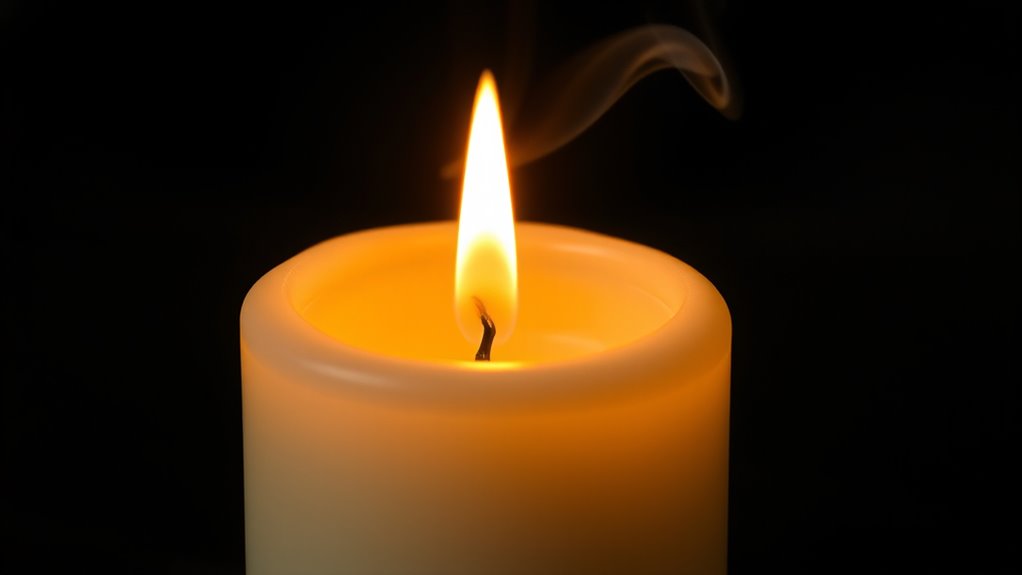Candles release only tiny amounts of chemicals during burning, which makes them safe for most indoor use when proper precautions are taken. Burning candles in well-ventilated spaces quickly disperses any emissions, and choosing high-quality candles with natural waxes like soy or beeswax reduces potential pollutants further. Proper wick trimming and avoiding prolonged burning also help maintain safety. If you want to learn more about how candles impact indoor air, keep exploring the facts.
Key Takeaways
- Candles emit only trace amounts of chemicals; proper ventilation prevents buildup and minimizes indoor air pollution.
- Modern candles made from soy or beeswax produce fewer pollutants than traditional paraffin candles.
- Controlled burning and regular wick trimming reduce the release of potential toxins.
- Occasional candle use in well-ventilated spaces is unlikely to significantly affect indoor air quality.
- Most concerns are based on misconceptions; natural ingredient candles are a safe alternative for scenting your home.

Candles may create a cozy ambiance, but they can also release harmful toxins into your home. Many people worry about the safety of scented candles, especially when it comes to their indoor air quality. It’s understandable—after all, candles burn, and any combustion process can produce pollutants.
However, the idea that your everyday candle is filling your space with dangerous toxins isn’t entirely accurate. In fact, most candles, when used properly, pose minimal risk to your indoor air.
Scented candles are popular for their pleasant aromas, but they do emit small amounts of chemicals during burning. These chemicals come from the fragrance oils and the wax itself. Some concern has been raised about volatile organic compounds (VOCs), which are released in trace amounts.
But the key point is that the levels are typically very low, especially when you burn candles correctly. Good ventilation and proper candle maintenance considerably reduce any potential buildup of indoor air pollutants.
It’s important to remember that burning candles in a well-ventilated room disperses any emissions quickly, preventing them from accumulating to harmful levels.
Many of these worries stem from misconceptions about what constitutes “toxins” and how they behave indoors. The reality is that occasional, moderate use of scented candles doesn’t cause a notably increase in indoor pollutants.
Modern candles are often made with safer waxes, such as soy or beeswax, which produce fewer emissions compared to traditional paraffin wax. When you choose high-quality candles and follow burning guidelines—like trimming the wick to about a quarter inch before lighting and not leaving candles unattended—the risks are further minimized.
Additionally, proper ventilation plays a crucial role in maintaining indoor air quality during candle use. Implementing ventilation practices can further help dilute any emissions and enhance indoor air safety. If you’re still concerned about indoor air quality, you can opt for candles made with natural ingredients or consider alternatives like essential oil diffusers. These options can provide similar scents without the combustion process, therefore eliminating any worries about toxins.
But if you love candles, there’s no need to feel guilty about lighting them occasionally. Just remember that proper usage and good ventilation are your best defenses.
Frequently Asked Questions
Are All Candle Scents Safe to Burn Indoors?
Not all candle scents are safe to burn indoors. Candle scent misconceptions often lead people to believe all fragrances release harmful toxins, but many candles use natural essential oils that don’t harm indoor air quality.
To keep your space safe, choose candles from reputable brands that prioritize non-toxic ingredients. Always burn candles in well-ventilated areas and avoid prolonged exposure, ensuring a cozy atmosphere without compromising your indoor air quality.
How Long Does It Take for Candle Toxins to Dissipate?
Imagine a gentle breeze clearing fog from a meadow—candle toxin levels follow a similar path. Typically, dissipation timeline varies, but within 30 minutes to an hour after extinguishing, most toxins reduce considerably.
Ventilation speeds this process, allowing fresh air to sweep away lingering particles. Keep your space well-ventilated, and you’ll notice the air becoming clearer, safer, much sooner than you might think.
Can Candle Toxins Cause Long-Term Health Issues?
You wonder if candle toxins could cause long-term health issues. While indoor air quality can be affected by certain candles, proper candle safety minimizes risks.
Burning candles with clean, natural ingredients reduces harmful emissions. Ventilate your space regularly and choose candles wisely.
Although some toxins may pose concerns, following safety tips helps protect your health. Overall, responsible candle use supports good indoor air quality without long-term health worries.
Do Natural or Soy Candles Produce Fewer Toxins?
You ask if natural or soy candles produce fewer toxins, and the answer is yes. Candle safety involves choosing candles made from natural or soy wax, which release fewer harmful chemicals into indoor air.
These candles typically produce less soot and fewer volatile organic compounds, making them a safer option for maintaining good indoor air quality.
Switching to soy or natural candles can help you enjoy a cozy atmosphere without compromising your health.
What Are the Best Practices for Burning Candles Safely?
Think of your candle as a tiny lighthouse; its safety depends on proper maintenance. To guarantee candle flame safety, always trim the wick to about a quarter inch before lighting, preventing soot and excessive flickering.
Keep the candle away from drafts, and never leave it unattended.
Following these simple practices helps you enjoy your candle’s warm glow without worries, making your space both cozy and safe.
Conclusion
Remember, not everything that glitters is harmful. While it’s easy to worry about candle toxins, most candles are safe when used properly. Instead of jumping to conclusions, do your research and make informed choices. Like the saying goes, “Better safe than sorry.” So enjoy your candles responsibly, savoring their warmth and scent without unnecessary fear. Trust what you know, and let your common sense guide you to safe, cozy moments.









